The Great Indian Bustard (Ardeotis nigriceps) is an emblem of India’s diverse and vanishing avian heritage. This majestic bird, once widespread across the Indian subcontinent, now faces the imminent threat of extinction.
Renowned for its impressive size and distinctive appearance, the Great Indian Bustard inhabits arid and semi-arid grasslands, symbolizing the unique ecosystems it relies upon.
However, rampant habitat loss, hunting, and collisions with power lines have pushed this species to the brink of extinction, earning it the status of critically endangered.
Despite its ecological and cultural significance, the Great Indian Bustard remains perilously close to fading into obscurity.
Efforts to conserve this iconic bird require urgent action and collaboration among stakeholders to safeguard its future and preserve the rich biodiversity of the Indian landscape.
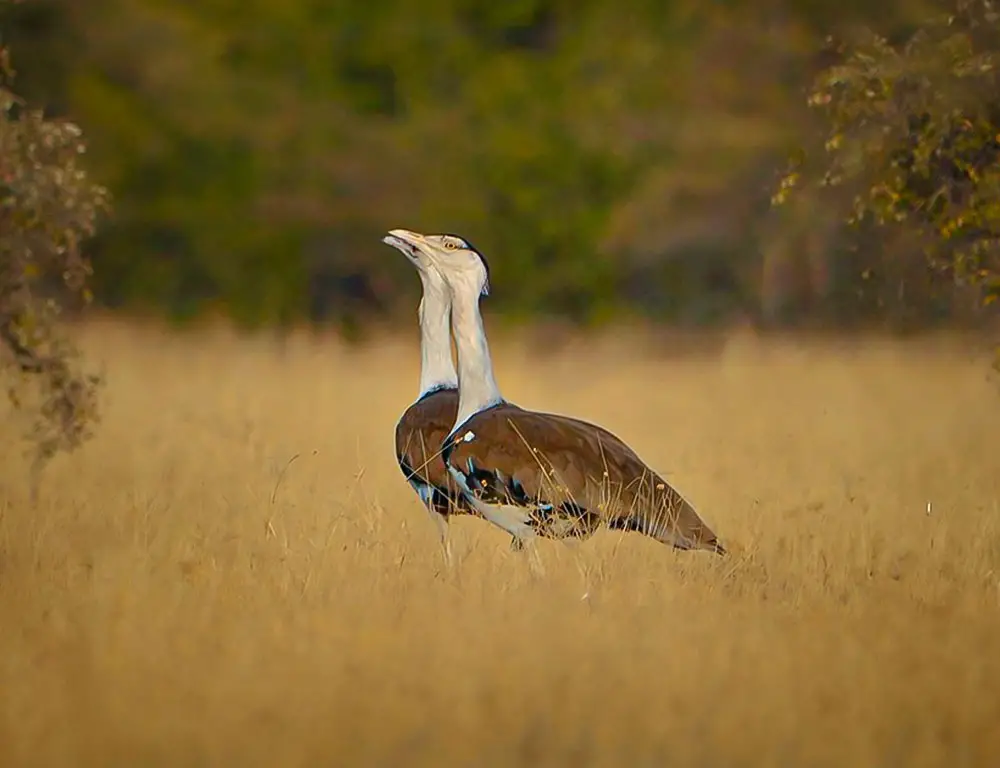
Main Characteristics Of Great Indian Bustard
The Great Indian Bustard is a large and majestic bird belonging to the Otididae family. It is endemic to the Indian subcontinent, where it inhabits arid and semi-arid grasslands, scrublands, and deserts.
Physical Characteristics Of Great Indian Bustard
It is also the state bird of Rajasthan and one of the heaviest-flying birds in the world. Here are some of the physical characteristics of this endangered and elusive bird:
Size and shape
The Great Indian Bustard is about 1 m tall and weighs around 15 kg. It has a long neck, a large head, a short tail, and long legs. The wingspan is about 2.5 m. The body is streamlined and aerodynamic, adapted for fast and powerful flight.
Color and pattern
The Great Indian Bustard has mostly brown and white plumage with some black markings. The head and neck are white, with a black crown and band across the eyes.
The upperparts are brown, with black and white spots and bars. The underparts are white, with a black breast band and a black patch on the lower belly.
The tail is brown, with white tips. The legs and feet are yellow. The bill is grey, and the eyes are dark brown.
Sexual dimorphism
The Great Indian Bustard exhibits sexual dimorphism, which means that the male and female have different appearances. As described above, the male is much larger and heavier than the female.
The male also has a longer, thicker neck, a more prominent black breast band, and a belly patch. The male also has a conspicuous white nuchal crest and a tuft of feathers on the back of the neck.
The female is smaller and duller, with a shorter, thinner neck and a less distinct black breast band and belly patch. The female lacks the nuchal crest.
Moult
The Great Indian Bustard undergoes a partial molt once a year, usually after the breeding season. During this time, the bird may lose some of its feathers, especially on the head, neck, and wings.
The molt lasts for about a month, and the bird regains its fresh and glossy plumage afterward.
Voice
The Great Indian Bustard is a silent and secretive bird that rarely vocalizes. The male may produce a low and booming call during the breeding season, which can be heard from a distance.
The call attracts females, defends territories, and communicates with other males.
The female may produce a soft and high-pitched call when alarmed or in contact with the male or the chicks. The chicks may produce a peeping or chirping sound when hungry or distressed.
Diet and Nutrition
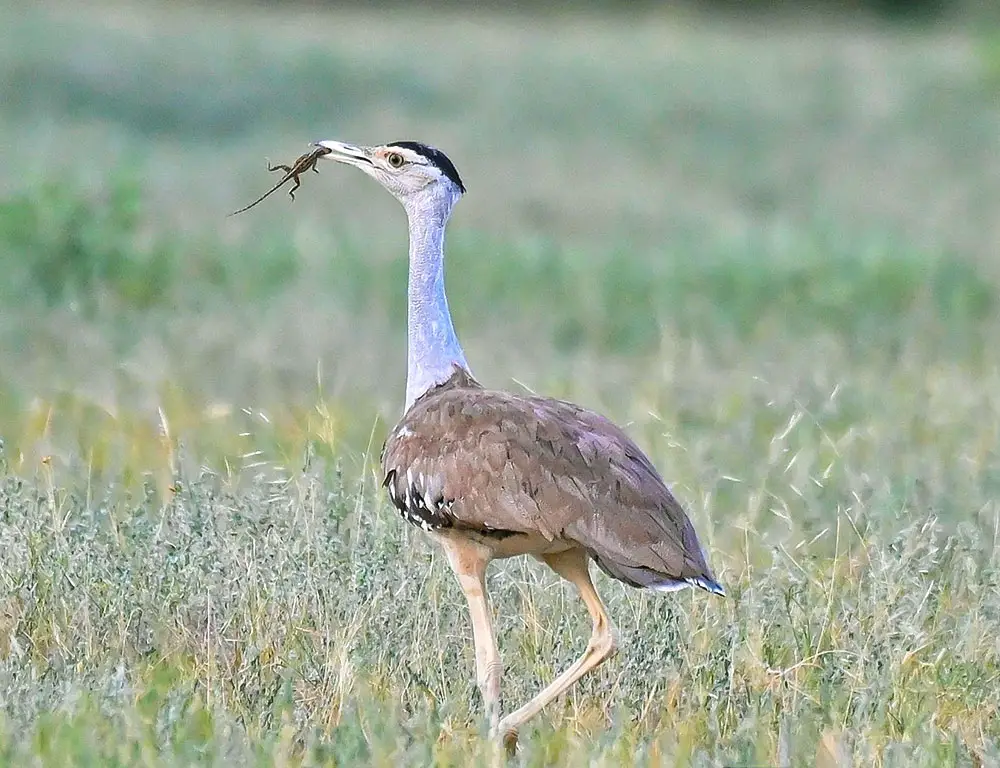
The Great Indian Bustard is an omnivorous and opportunistic bird, feeding on various plant and animal matter. It mainly eats seeds, fruits, flowers, buds, leaves, and shoots of grasses, herbs, and shrubs.
It also eats insects, worms, lizards, snakes, rodents, frogs, and eggs. The bird forages on the ground or in low vegetation, often walking or running.
It may also dig or probe the soil with its bill to find food. It needs to drink water regularly and may visit ponds, streams, or wells to quench its thirst.
Behavior And Ecology
The Great Indian Bustard is a diurnal and nomadic bird active from dawn to dusk. It is usually seen singly or in small groups, but may form larger flocks during the non-breeding season.
It is a shy and wary bird which avoids human disturbance and contact. It is also a territorial and aggressive bird that defends its home range and resources from intruders.
It is a fast and powerful flyer, which can reach speeds of up to 80 km/h. It can also run and walk swiftly on the ground, using its long legs and strong feet.
Threats
The Great Indian Bustard is one of the most threatened birds in the world, with an estimated population of less than 300 individuals.
Due to agricultural expansion, urbanization, mining, and infrastructure development, it faces several threats, such as habitat loss, degradation, and fragmentation.
It also suffers from hunting, poaching, and trapping for meat, feathers, and trophies. It is also vulnerable to predation, collision, and electrocution by natural and artificial enemies, such as dogs, foxes, eagles, and power lines.
It is also affected by diseases, parasites, and inbreeding due to its low genetic diversity and small population size.
Conservation
The Great Indian Bustard is listed as Critically Endangered by the IUCN Red List and is protected by law in India and Pakistan. It is also included in Appendix I of CITES, which bans its international trade.
Several conservation measures have been taken to save this bird, such as establishing and managing protected areas, restoring and enhancing its habitat, reducing and preventing human disturbance and interference, enforcing and strengthening laws and regulations, raising awareness and education, and conducting research and monitoring.
Some of these efforts have shown positive results, such as increasing the population and distribution of the bird in some areas. Still, more actions are needed to ensure its long-term survival and recovery.
Evolution
The Great Indian Bustard is an ancient and unique bird, which belongs to the order Otidiformes, which contains only one family, Otididae, and about 26 species of bustards.
It is closely related to the African and Eurasian bustards, such as the Kori Bustard and the Great Bustard, but has diverged from them about 15 million years ago. It is also distantly related to the cranes, rails, and turacos, but has evolved independently from them.
It has adapted to its arid and semi-arid environment by developing features such as a large body, a long neck, a short tail, and a thick bill, which help it survive and thrive in harsh conditions.
Reproduction
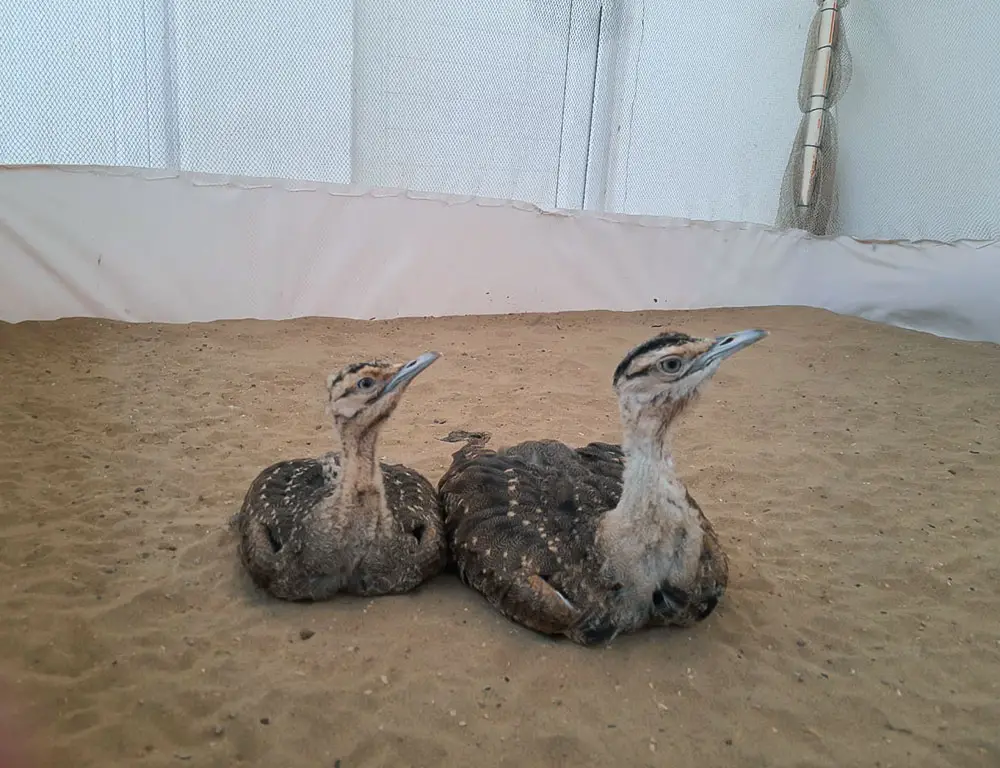
The Great Indian Bustard breeds from November to March, depending on the region. The male displays spectacular courtship behavior, which involves inflating his neck, erecting his nuchal crest, spreading his tail, and strutting around.
The male also makes his booming call and chases or fights with other males. The female chooses the most dominant and attractive male and mates with him.
The nest is a shallow scrape on the ground, usually under a bush or a tree. The female lays one or two eggs, which are olive-green with brown spots.
The incubation period is about 26 to 28 days, and the chicks are precocial, which means they can walk and feed themselves soon after hatching.
The female cares for the chicks and protects them from predators. The fledging period is about 40 to 45 days, and the young may stay with the mother for up to a year.
Food
The Great Indian Bustard is an omnivorous and opportunistic bird, feeding on various plant and animal matter.
It mainly eats seeds, fruits, flowers, buds, leaves, and shoots of grasses, herbs, and shrubs. It also eats insects, worms, lizards, snakes, rodents, frogs, and eggs.
The bird forages on the ground or in low vegetation, often walking or running. It may also dig or probe the soil with its bill to find food. It needs to drink water regularly and may visit ponds, streams, or wells to quench its thirst.
Taxonomy
Here’s a simplified table of the taxonomy of the Great Indian Bustard:
| Taxonomic Level | Classification |
| Kingdom | Animalia |
| Phylum | Chordata |
| Class | Aves |
| Order | Otidiformes |
| Family | Otididae |
| Genus | Ardeotis |
| Species | Ardeotis nigriceps |
This classification places the Great Indian Bustard within the animal kingdom (Animalia), the chordate phylum (Chordata), the class of birds (Aves), the order of bustards (Otidiformes), the bustard family (Otididae), the genus Ardeotis, and the species Ardeotis nigriceps.
Nesting Habit
Here’s a simplified table outlining the nesting habits of the Great Indian Bustard:
| Nesting Habit | Description |
| Nest Type | Simple scrape on the ground |
| Nest Material | Minimal, may include grass or twigs lining the scrape |
| Nest Location | Male clears a shallow depression in the ground, often near a prominent landmark. |
| Nest Construction | Chicks leave the nest shortly after hatching but remain dependent for weeks |
| Nesting Season | Typically breeds during the monsoon season, from July to September |
| Clutch Size | Usually lays a single egg |
| Incubation | Both males and females share incubation duties |
| Incubation Period | Around 24-25 days |
| Fledging Period | Chicks leave the nest shortly after hatching but remain dependent for weeks. |
| Nesting Success | Low due to predation, habitat disturbance, and human activities |
This table summarizes the nesting behaviors and characteristics of the Great Indian Bustard, providing insights into its reproductive ecology and habitat preferences.
Ranging Map Of Great Indian Bustard
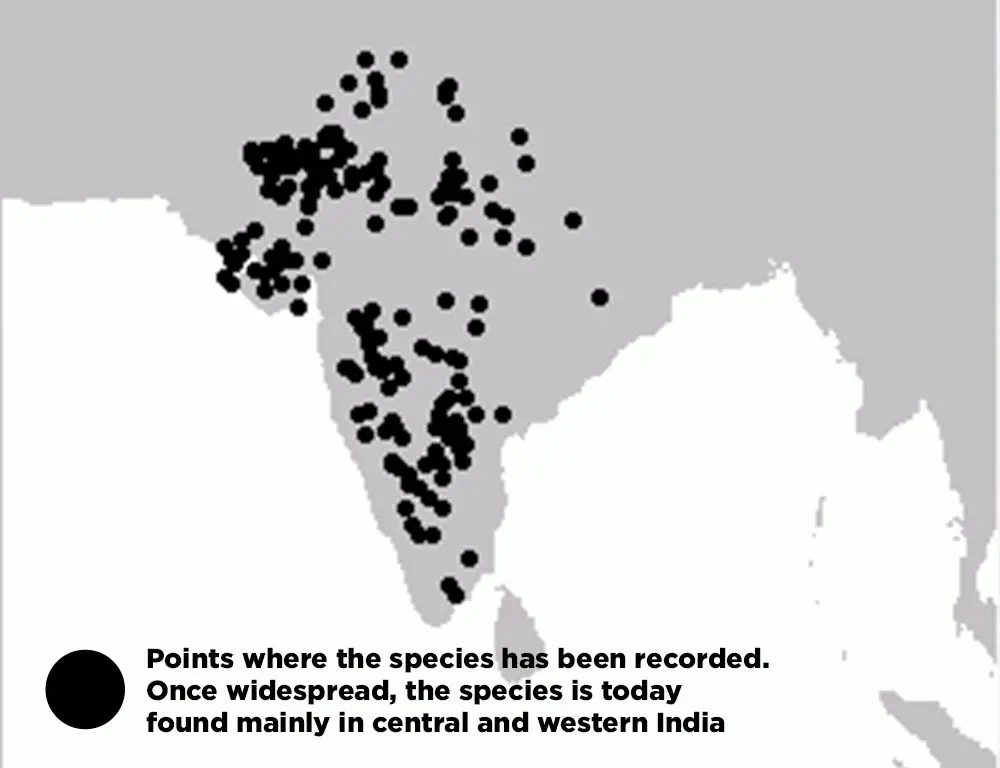
The Ranging Map of the Great Indian Bustard (GIB) is a crucial tool used by conservationists, researchers, and policymakers to understand this critically endangered bird species’ distribution, habitat preferences, and movement patterns.
The Great Indian Bustard, scientifically known as Ardeotis nigriceps, is one of the heaviest flying birds and is endemic to the Indian subcontinent.
It is listed as critically endangered by the International Union for Conservation of Nature (IUCN) due to severe population declines primarily attributed to habitat loss, hunting, and disturbance.
10 Interesting Facts About Great Indian Bustard
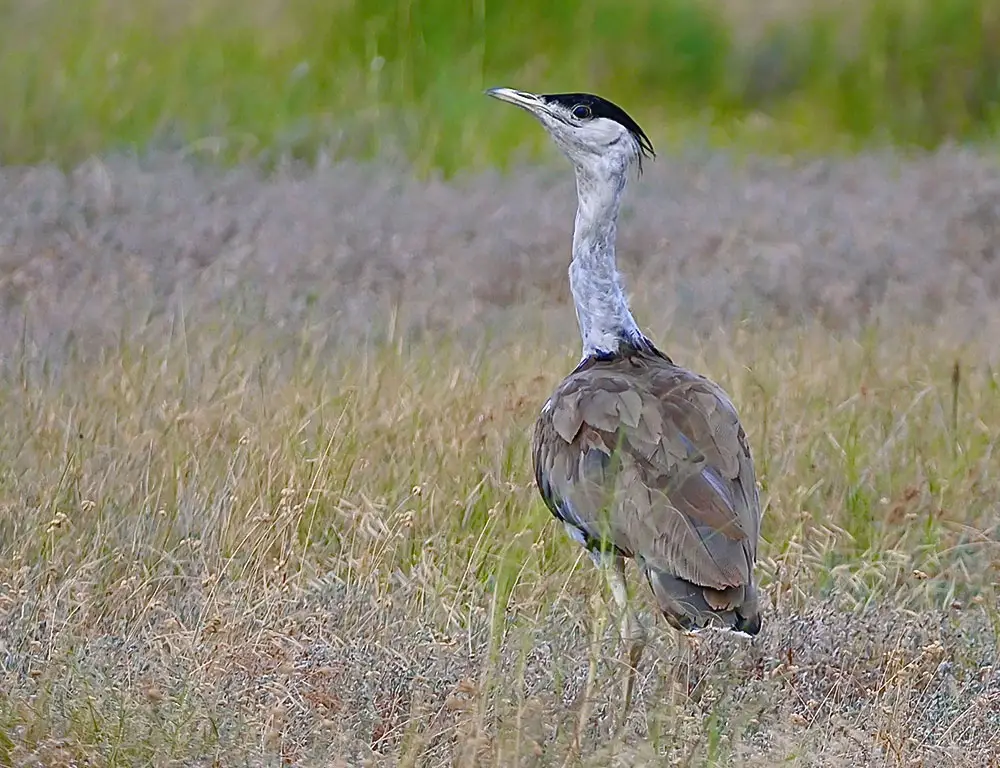
Here are 10 interesting facts about the Great Indian Bustard:
Endangered Status
The Great Indian Bustard (Ardeotis nigriceps) is categorized as critically endangered by the International Union for Conservation of Nature (IUCN). Its population has drastically declined primarily due to habitat loss, hunting, and power line collisions.
Large Size
It is one of the heaviest flying birds in the world, with males weighing between 10 to 15 kilograms (22 to 33 pounds) and females slightly smaller.
Distinctive Appearance
The Great Indian Bustard has a striking appearance with a brownish body, long bare legs adapted for walking in grasslands, a black crown on the head, and a white patch on the neck.
Habitat Preference
It primarily inhabits dry grasslands, semi-arid plains, and open country with sparse vegetation. These habitats provide ideal conditions for foraging and nesting.
Nomadic Behavior
The species exhibits nomadic behavior, often moving over large distances in search of suitable feeding and breeding grounds. Seasonal changes influence their movements in vegetation and water availability.
Courtship Display
During the breeding season, male Great Indian Bustards perform elaborate courtship displays to attract females. These displays involve inflating the throat sac, erecting the feathers, and emitting booming calls to establish dominance and attract mates.
Low Reproductive Rate
Great Indian Bustards have a low reproductive rate, with females typically laying only one egg per breeding season. This, coupled with high chick mortality rates, makes population recovery challenging.
Threats From Agriculture
Agricultural expansion and intensification have led to widespread habitat loss and fragmentation, posing a significant threat to the species’ survival. Increasing grasslands into croplands reduces available foraging and nesting habitat for the bustards.
Conservation Efforts
Various conservation initiatives have been undertaken to save the Great Indian Bustard from extinction. These include habitat restoration, community-based conservation programs, captive breeding efforts, and measures to mitigate threats like power line collisions.
Cultural Significance
The Great Indian Bustard holds cultural significance in the regions where it occurs. It is considered a wilderness symbol and revered in local folklore and traditions.
Efforts to conserve this species often involve local communities and stakeholders to promote coexistence and sustainable land use practices.
These facts underscore the importance of concerted conservation efforts to protect the Great Indian Bustard and its unique habitat from further decline and ensure its survival for future generations.
Conclusion
In the face of mounting challenges, the fate of the Great Indian Bustard hangs in the balance, highlighting the urgent need for conservation action.
As custodians of our natural heritage, we must prioritize efforts to protect and restore the habitats upon which this magnificent bird depends.
By addressing key threats such as habitat loss, hunting, and infrastructure development, we can pave the way for the recovery of the Great Indian Bustard population.
Additionally, fostering community engagement and raising awareness about the plight of this species are vital steps towards ensuring its survival.
Through concerted conservation measures and collaborative initiatives, we can aspire to secure a brighter future for the Great Indian Bustard, preserving its legacy for generations to come and upholding the invaluable biodiversity of the Indian subcontinent.
